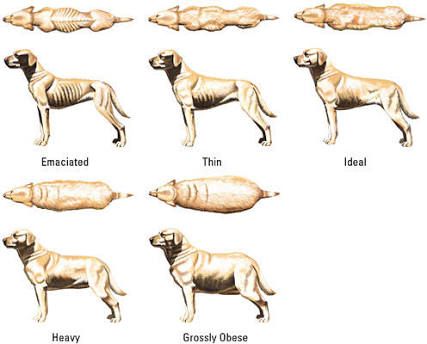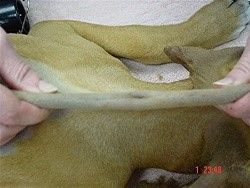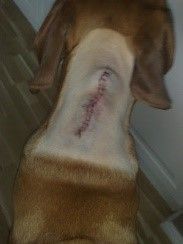Health

HEALTH
Regular exercise, grooming and good diets are essential for the health of your dog. Grooming includes checking of the ears (making sure they are clean and have no discharge), brushing which will loosen and remove hair ready to be dropped (this will help stop hair ending up on your floors also) and will distribute natural oils through the coat making your dog’s coat healthier and shiny. Nail clipping (this should be started at an early age so your dog is use to it) be careful not to cut the quick. Ask your breeder to show you how these things are done if you’re not sure. A bath about once a month (unless very dirty in between) also keeps your dog’s coat healthy. Don’t forget also to wash any bedding regularly
Your dog will also need to be wormed regularly, your breeder should tell you when your puppy’s next all wormer is due, Adults are wormed approximately every 3 months. Worming isn’t only important for your dog’s health; it is also important because some parasites can be passed on and cause human health problems. You also need to think about heartworm prevention. Heartworm is contracted by your dog from mosquitoes and they require year-round protection. There are daily heartworm tablets, monthly heartworm prevention or when your puppy is older, about 12 months, your vet can give it a yearly heartworm needle. For convenience there are some products available that treat heartworm, intestinal worms, mite, lice and fleas all in one application but these products usually do not treat ticks or tape worm so you would have treat for tape worm about every 6 months and treat for ticks with a different product. Protocols can vary greatly and Your breeder and vet can help you with more advice. Vaccinations As discussed, your breeder should have given your puppy its 1st Vaccination at about 6 to 8 week it will be due again around 12 to 14 weeks and it is recommended to give a third at 16 to 18 weeks especially in high Parvovirus areas. You can also get you dog vaccinated against kennel cough which is normally given with the 2nd and 3rd vaccination (C5). This is recommended as kennel cough is like our flu and highly contagious.
EXPLAINATION OF SOME HEALTH PROBLEMS KNOWN IN THE RHODESIAN RIDGEBACK
Health problems can occur with the RR, as with any breed. Buying a puppy from a registered breeder that breeds selectively can help to limit the possibility of your puppy developing health problems at a later date due to conditions inherited from its parents. Even though there are no compulsury requirements for health testing RR in Australia responsible breeders strive to produce healthy puppies and ensure the continuation of the Rhodesian Ridgeback by testing as a minimum Hips and Elbows, Dermoid Sinus, Degenerative Myelopathy and Juvenile Myoclonic Epilepsy
Dermoid Sinus A dermoid sinus, also known as a pilonidal sinus, is a tubular skin defect caused by incomplete separation of the skin and the nervous system during embryonic development. The sinus can be found at any point along the back or neck, but most commonly affects the neck or upper spine. The depth of the defect varies, the tube:
- may extend into the tissue just beneath the skin,
- may extend deeper and connect to the membrane covering the spinal cord (dura mater) or
- it may be a blind ended sac beneath the skin
Dermoid sinus is most common in Rhodesian ridgebacks,it is congenital and heritable. Therefore, affected pets should not be bred. The condition has also been reported in other breeds. A dermoid sinus can be recognized at a young age as an opening on the midline of the back with protruding hair, often in a swirl. A tube or cord may be felt beneath the opening. Some dermoid sinuses may not be associated with any clinical signs or may be associated with mild discharge that can be controlled with gentle cleansing. However, sinuses that become plugged with keratin debris may become infected and an abscess may form. Sinuses that connect to the lining of the spinal cord can be associated with neurologic abnormalities. The prognosis for dogs with dermoid sinus is very good if no neurological signs are present. Failure to remove the sinus entirely results in redevelopment of the sinus which may require a second surgery to search for remnants of the tube that were left behind. Presently there is no DNA Test for this condition. Experienced breeders feel for the condition and along with puppy vet health checks most DS is picked up before pups join their families and either treated or in severe cases the pup is humanly euthanised.



Degenerative Myelopathy (DM) is an uncommon, progressive degenerative disease that causes hind limb weakness and paralysis and eventually affects the front limbs, as well. The symptoms of DM start gradually, usually in adult dogs over 5 years of age. Early in the course of the disease, affected dogs will start to lose muscle coordination and balance in their rear legs (ataxia). They will develop slight or incomplete hind end paralysis (paraparesis), which will progress to total rear end paralysis (paraplegia), accompanied by varying degrees of urinary and/or faecal incontinence. As the dog loses its ability to stand and use its hind legs, it may develop bed sores and wounds from urine scalding, which can be extremely painful. It usually takes somewhere between 6 and 12 months for full pelvic paralysis to develop in dogs with DM. The front legs will be affected next, starting with lack of coordinated movement (ataxia) and progressing to complete paralysis. The ability to chew and swallow can also be affected. When all 4 legs are paralysed, the condition is called “tetraplegia.” Tetraplegia usually occurs within several years of the diagnosis. The dog’s sensory perception abilities are unaffected by this disease, and most affected dogs do not suffer from pain. Some owners mistakenly assume that their older pets are developing arthritis, when DM is actually the culprit. Affected animals usually become incontinent late in the course of the disease, although they do not seem to be painful. In fact, one of the key clinical features of canine degenerative myelopathy is the absence of any localizable spinal pain. The mean age of affected dogs is 9 years, with males and females being affected equally. It is extremely uncommon for young dogs to develop DM.Theres a DNA test for this condition and inheritance is autosomal recessive
Juvenile Myoclonic Epilepsy (JME) is an inherited disease in the Rhodesian Ridgeback breed. Affected dogs start showing symptoms between the age of 6 weeks and 18 months. Symptoms include frequent myoclonic jerks or twitches especially when the dogs are sleeping or resting. Photo sensitivity has also been noticed in affected dogs. Most affected dogs will also develop more severe generalized and tonic clonic seizures. Due to the recessive mode of inheritance, affected dogs must inherit two copies of the mutation, one from each parent. There is now a DNA test for this condition. The test will tell you if your dog has 0, 1 or 2 copies of the mutation. Clear (N/N) and carriers (N/ JME) are healthy dogs and will not develop the specific symptoms associated with the JME mutation, however carriers should only be bred to clear dogs to avoid having affected puppies. There is a DNA test for this condition and inheritance is autosomal recessive Please note that there are other forms of epilepsy that cannot be eliminated by this test.
HIP DYSLASIA (HD) The term refers to the shape and fit of the Ball of the Femur with the socket of the hip. Some signs to look for are discomfort when running or running holding is back legs together (bunny hoping), discomfort when rising or if your dog seems to be unwilling to use its hind legs. As discussed, responsible breeders adhere to strict guide lines and only breed from stock that has been x-rayed and falls within the set parameters.
HD is considered a Polygenic disorder so is more difficult for breeders to manage. To manage polygenic disorders, they must be considered as threshold traits. A number of genes must combine to cross a threshold producing an affected individual. We also know that the environment has a role in the expression of hip dysplasia. Overnutrition and excessive environmental trauma during the critical growth periods will promote later dysplastic development. There is no DNA test
OSTEOCONDRITIS (OCD) / ELBOW DYSPLASIA canine elbow dysplasia (ED) is a disease of the elbows of dogs caused by growth disturbances in the elbow joint. There are a number of theories as to the exact cause of the disease that include defects in cartilage growth, trauma, genetics, exercise, diet and so on. It is likely that a combination of these factors leads to the condition, usually showing up between 4 and 9 months in rapidly growing puppies. It presents as a lameness and pain in the joint. It can be difficult to diagnose so do not rush into surgery. Responsible breeders have all dogs/bitches elbow x-rayed before breeding.
CRUCIATE LIGAMENT Limping in the hind legs doesn’t necessarily mean your dog has hip dysplasia. The anterior cruciate ligament is located in the stifle (Knee) of the dog and is important as it helps keep the knee strong and stabilized when moving. If the ligament tears the knee becomes unstable, inflamed and causes joint damage. This tear can occur due to degenerative changes in the ligament or from an accident which has damaged the ligament. In large breeds surgery is required to repair the damage.
TEETH PROBLEMS A RR is required to have a scissor bite to be bred from A scissor bite is where the top teeth fit closely over the bottom teeth. There are variations to a scissor bite for e.g.: being undershot, overshot or having a wry mouth these conditions don’t usually affect the dog except for the fact that it is not permitted to be bred with. A RR must also have a correct dentition of 42 adult teeth. 20 upper and 22 lower teeth. Missing teeth do not cause the dog problems except this also renders them not suitable to be bred with.
BLOAT is a condition where the stomach over-distends with gas and can twist. Large breeds with deep chest are susceptible to this condition. Early signs are restlessness and stomach pain. Then they may begin vomiting, usually saliva, or retching and their discomfort increases until the dog becomes weaker with laboured breathing. The dog can collapse and die, this can happen very quickly so it is a matter of urgency to get your dog to the vet.
HEAT STRESS Can kill your dog. DO NOT leave your dog in a car even for a short time. Cars heat up very quickly and become furnaces even in the shade. Cool by placing the dog on a cool wet surface and increase the air circulating around, possibly with a fan. Heat stress can cause organs to start shutting down and if this doesn’t kill your dog it can cause brain damage.
There are many illnesses that can affect a dog; this information is not meant to scare you but to make you aware. Not every little thing will require a vet but use your common sense. You as an owner, hopefully, will spend much more time with your dog than anyone else so are much more likely to know when something isn’t quite right.
Contact Details
Please visit the clubs contact page for Details
